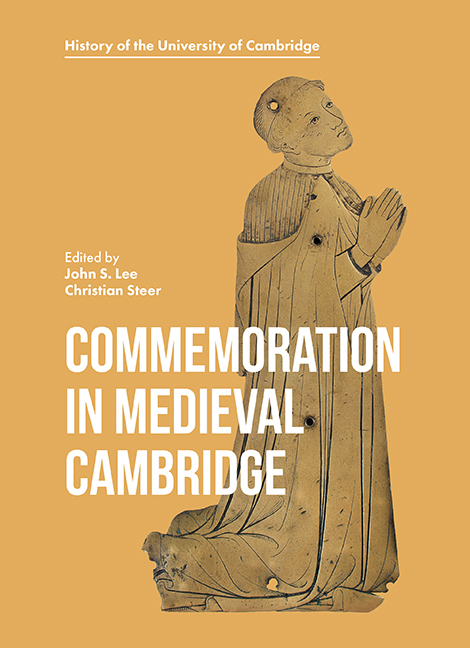Book contents
- Frontmatter
- Contents
- List of Illustrations
- Acknowledgements
- List of Contributors
- Abbreviations
- Introduction: In Fellowship with the Dead
- 1 Monuments and Memory: A University Town in Late Medieval England
- 2 The Commemoration of the Living and the Dead at the Friars Minor of Cambridge
- 3 The City of London and the Founding of the Guild of Corpus Christi
- 4 Patrons and Benefactors: The Masters of Trinity Hall in the Later Middle Ages
- 5 A Comparison of Academical and Legal Costume on Memorial Brasses
- 6 Commemoration at a Royal College
- 7 Cambridge Commemorations of Lady Margaret Beaufort's Household
- 8 ‘The Stones are all disrobed’: Reasons for the Presence and Absence of Monumental Brasses in Cambridge
- Bibliography
- Index
6 - Commemoration at a Royal College
Published online by Cambridge University Press: 25 October 2019
- Frontmatter
- Contents
- List of Illustrations
- Acknowledgements
- List of Contributors
- Abbreviations
- Introduction: In Fellowship with the Dead
- 1 Monuments and Memory: A University Town in Late Medieval England
- 2 The Commemoration of the Living and the Dead at the Friars Minor of Cambridge
- 3 The City of London and the Founding of the Guild of Corpus Christi
- 4 Patrons and Benefactors: The Masters of Trinity Hall in the Later Middle Ages
- 5 A Comparison of Academical and Legal Costume on Memorial Brasses
- 6 Commemoration at a Royal College
- 7 Cambridge Commemorations of Lady Margaret Beaufort's Household
- 8 ‘The Stones are all disrobed’: Reasons for the Presence and Absence of Monumental Brasses in Cambridge
- Bibliography
- Index
Summary
The commemorative practices of a college founded by Henry VI, crowned king of England in 1429 and king of France in 1431, were inevitably different to those of any other Cambridge college. They reflected the personal and express wishes of the royal founder in respect of his family and himself, and they also reflected the scale and diversity of the endowments he and his successors made to his college. The commemorative practices of other donors who wished to be associated with the royal college, and of individual members of the foundation, were in turn influenced by those of the founder. But at the same time the way in which Henry VI framed his foundation, and the statutes he gave to the college, were modelled on the practices of his own father Henry V and those of William Wykeham, the founder of Winchester College and New College, Oxford. This applied as much to commemoration as to other features of the new foundation.
FOUNDATIONS
The College of the Blessed Virgin Mary and St. Nicholas was the first college at Oxford or Cambridge set up by a reigning monarch. Its foundation, with that of its sister Eton College, may have been the first independent initiative by the young Henry VI. Remarkably, he decided to lay the foundation stone of his new college at Cambridge with his own hands, and the ceremony took place just ten weeks after the acquisition of the site, on Easter Sunday, 2 April 1441. The inspiration for this novel act of commemoration may have been his father Henry V's laying of the foundation stone of the Bridgettine abbey of Syon in 1415. Henry VI repeated the act of laying the foundation stone for his other college of Eton on 11 June 1441, two months later. The ceremony attending these royal foundations probably followed the liturgy laid down in pontificals like that of William Durandus written in the late thirteenth century. There would have been a blessing of the stone, with the king taking the role normally assumed by the bishop, on the analogy of a baptismal rite. The stone would then have been lowered into the foundation trench.
- Type
- Chapter
- Information
- Commemoration in Medieval Cambridge , pp. 106 - 122Publisher: Boydell & BrewerPrint publication year: 2018



